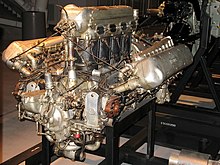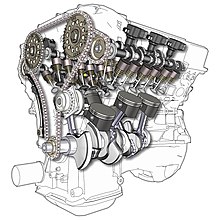Engine configuration
Theengine configurationdescribes the fundamental operating principles by whichinternal combustion enginesare categorized.
Piston engines are often categorized by their cylinder layout, valves and camshafts.Wankel enginesare often categorized by the number of rotors present. Gas turbine engines are often categorized into turbojets, turbofans, turboprops and turboshafts.
Piston engines
[edit]
Piston enginesare usually designed with thecylindersin lines parallel to thecrankshaft.It is called astraight engine(or 'inline engine') when the cylinders are arranged in a single line.
Where the cylinders are arranged in two or more lines (such as inV enginesorflat engines), each line of cylinders is referred to as a 'cylinder bank'. The angle between cylinder banks is called the 'bank angle'. Engines with multiple banks are shorter than straight engines of the same size, and will often have betterengine balancecharacteristics, resulting in reduced enginevibrationand potentially higher maximum engine speeds.
Most engines with four or less cylinders use astraight enginelayout, and most engines with eight cylinders or more use aV enginelayout. However, there are various exceptions to this, such as thestraight-eight enginesused by various luxury cars from 1919-1954,[1][2][3]V4 enginesused by some marine outboard motors,V-twinandflat-twinengines used by motorcycles andflat-four enginesused by various cars.
Single cylinder bank
[edit]
Straight engines(also known as "inline engines" ) have all cylinders aligned in one row along the crankshaft with no offset. When a straight engine is mounted at an angle, it is sometimes called a "slant engine". Types of straight engines include:
- Single cylinder
- Straight-2,also known as "parallel twin"
- Straight-3,also known as "inline-triple"
- Straight-4
- Straight-5
- Straight-6
- Straight-8
Multiple cylinder banks
[edit]V engines
[edit]
V engines(also known as "Vee engines" ) have the cylinders aligned in two separate planes or 'banks', so that they appear to be in a "V" when viewed along the axis of the crankshaft. Types of V engines include:
VR5 and VR6 engines are very compact and light, having a narrow V angle which allows a singlecylinder blockandcylinder head.
Flat engines
[edit]
Flat engines(also known as "horizontally-opposed" or "boxer" engines) have the cylinders arranged in two banks on either side of a single crankshaft. Types of flat engines include:
W engines
[edit]W engines have the cylinders in a configuration in which the cylinder banks resemble the letter W, in the same way those of a V engine resemble the letter V. Types of W engines include:
Other layouts
[edit]Radial engineshave cylinders mounted radially around a central crankcase.Rotary engineshave a similar configuration, except that the crankshaft is fixed and the cylinders rotate around it. (This is different from theWankel engineconfiguration described below.) Radial and rotary engine designs were widely used in earlyaircraft engines.
U enginesconsist of two separate straight engines (complete with separate crankshafts) joined by gears or chains. Most U engines have four cylinders (i.e. two straight-two engines combined), such assquare four enginesandtandem twin engines.Similar to U engines,H enginesconsist of two separate flat engines joined by gears or chains. H engines have been produced with between 4 and 24 cylinders.
Anopposed-piston engineis similar to a flat engine in that pairs of pistons are co-axial but rather than sharing a crankshaft, instead share a single combustion chamber per pair of pistons. The crankshaft configuration varies amongst opposed-engine designs. One layout has a flat/boxer engine at its center and adds an additional opposed-piston to each end so there are two pistons per cylinder on each side.
AnX engineis essentially two V engines joined by a common crankshaft. A majority of these were existing V-12 engines converted into an X-24 configuration.
TheSwashplate enginewith the K-Cycle engine is where pairs of pistons are in an opposed configuration sharing a cylinder and combustion chamber.
A Delta engine has three (or its multiple) cylinders having opposing pistons, aligned in three separate planes or 'banks', so that they appear to be in a Δ when viewed along the axis of the main-shaft. An example of this type of layout is theNapier Deltic.
Wankel (rotary) engines
[edit]This sectionneeds expansion.You can help byadding to it.(August 2019) |
Wankel engines(sometimes called 'rotary engines') can be classified based on the number of rotors present. Most production Wankel engines have two rotors, however engines with one, three and four rotors have also been produced.[4][5]Wankel engines can also be classified based on whether they arenaturally aspiratedorturbocharged.
Most Wankel engines are fueled by petrol, however prototype engines running on diesel and hydrogen have been trialed.
Gas turbine engines
[edit]This sectionneeds expansion.You can help byadding to it.(August 2019) |
Gas turbineengines— mostly used for aircraft— are usually separated into the following categories:
- Turbojet,gasses travel through a propelling nozzle
- Turbofan,gasses travel through a ducted fan
- Turboprop,gasses travel through an unducted propeller, usually with variable pitch
- Turboshaft,a gas turbine optimised for producing mechanical torque instead of thrust
See also
[edit]References
[edit]- ^Posthumus, Cyril(1977) [1977]. "War and Peace".The story of Veteran & Vintage Cars.John Wood, illustrator (Phoebus 1977 ed.). London: Hamlyn / Phoebus. p. 70.ISBN0-600-39155-8.
- ^"Engine of the Day: Packard Inline Eight".www.jalopnik.com.Retrieved15 November2019.
- ^Hemmings Classic Car.Vol. 6, no. 5. February 2010. p. 39.
{{cite magazine}}:Missing or empty|title=(help) - ^"Technically Interesting: Dr. Wankel's Quad-Rotor Mercedes SL".www.bringatrailer.com.21 March 2018.Retrieved31 August2019.
- ^"How a Four-Rotor Wankel Engine Works".www.roadandtrack.com.23 November 2016.Retrieved31 August2019.
